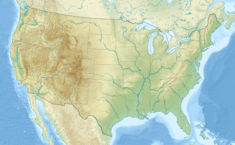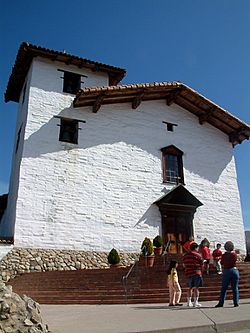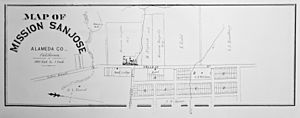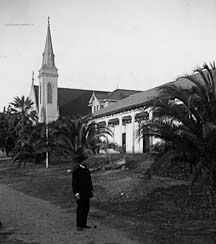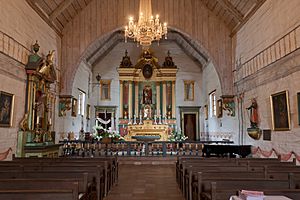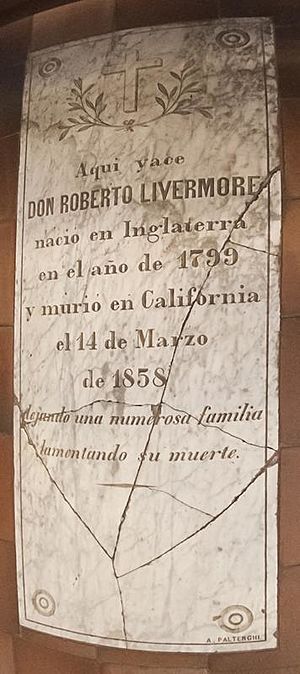Mission San José (California) facts for kids

The mission in 2011
|
|
| Location | 43300 Mission Blvd. Fremont, California 94539 |
|---|---|
| Coordinates | 37°31′58″N 121°55′10″W / 37.53278°N 121.91944°W |
| Name as founded | La Misión del Gloriosísimo Patriarca Señor San José |
| English translation | The Mission of the Glorious Patriarch Lord Saint Joseph |
| Patron | Saint Joseph |
| Founding date | June 11, 1797 |
| Founding priest(s) | Father Fermín Lasuén |
| Founding Order | Fourteenth |
| Headquarters of the Alta California Mission System | 1824–1827; 1830–1833 |
| Military district | Fourth |
| Native tribe(s) Spanish name(s) |
|
| Native place name(s) | Oroysom |
| Baptisms | 6,673 |
| Marriages | 1,990 |
| Burials | 4,800 |
| Secularized | 1834 |
| Returned to the Church | 1858 |
| Governing body | Roman Catholic Diocese of Oakland |
| Current use | Chapel / Museum |
| Designated | 1971 |
| Reference no. | 71000131 |
| Reference no. |
|
| Website | |
| http://www.missionsanjose.org/ | |
Mission San José is a historic Spanish mission located in Fremont, California. It was started on June 11, 1797, by Franciscan priests. This was the fourteenth Spanish mission built in California.
After a while, the mission began to decline. It suffered from neglect and earthquakes, leaving most of it in ruins. Over the years, people worked hard to rebuild many of the original structures. Today, the old mission church is still used as a chapel for Saint Joseph Catholic Church. There is also a visitor center and a museum where you can learn about the mission's history.
Contents
The Mission's Story
The idea for Mission San José began in 1772. A Spanish explorer named Juan Crespí first thought about building it in the San Ramon Valley. However, the Native American people there were not friendly towards the Spanish. So, the mission was built further south, in what is now Fremont, California.
Building the Mission
Work on Mission San José started in May 1797. Native American people from Mission Santa Clara, about 13 miles south, helped build it. Franciscan missionaries and Spanish overseers guided the work. The mission was built on hills overlooking the Fremont plain, near San Francisco Bay.
This area had been home to Native American groups for many years. These groups, like the Ohlone, spoke different languages. They lived by hunting and gathering plants. Their diet included seeds, roots, berries, acorn flour, small animals, deer, fish, and shellfish. Many local Native Americans had already been baptized at Mission Santa Clara. They returned home to help start the new Mission San José community.
The mission's walls were very thick, about 5 feet. The church itself was 126 feet long, 30 feet wide, and 24 feet high. It was made from adobe (sun-dried mud bricks) and redwood. The floor and walls were made of tiles.
Growing the Community
By the end of 1800, the mission had 277 new members, called "neophytes." These included both Ohlone and Bay Miwok speakers. By 1805, most Native Americans from the East Bay area had joined the missions.
In 1806, a serious measles outbreak reduced the mission's population. After this, people from more distant areas began to join. These new groups included the Yokuts from the San Joaquin Valley, who arrived around 1810. Later, Coast Miwok and Patwin people also moved to Mission San José.
By 1825, the Yokuts language was the most common among the 1,796 people at the mission. Later, Plains Miwok speakers also joined. By the time Mission San José closed as a large farming community in the 1830s, Plains Miwok was the main Native American language spoken there.
Music and Prosperity
Father Narciso Durán became the mission's leader in 1806. He stayed until 1833. Father Durán was a talented musician. He taught the neophytes music and created a choir and a 30-piece orchestra. This orchestra became famous throughout California.
The mission's first permanent adobe church was officially opened on April 22, 1809. Many valuable gifts, like special clothes for priests, religious statues, and paintings, were given to the mission. These items came from friends of the mission in California and other parts of the Spanish Empire.
Mission San José was a busy center for farming and industry. The location was chosen because it had plenty of water, good soil, stones, and adobe for building. Thousands of cattle grazed on mission lands. Large fields of wheat and other crops, like grapes, olives, and figs, were grown. In 1868, the mission produced a lot of wheat and other foods.
By 1832, the mission owned 12,000 cattle, 13,000 horses, and 12,000 sheep. These animals roamed lands from what is now Oakland to San Jose. Mission San José was one of the most successful missions in California.
Changes and Decline
In 1833, the Mexican government decided to change how the missions worked. This was called the Act for the Secularization of the Missions of California. This meant the missions would no longer be run by the church in the same way.
The Rancho Period (1836–1853)
During this time, the mission lands were slowly divided and sold to private owners. Father José González Rubio stayed at the mission for a while to manage the church. The Native American people who had lived at the mission faced many challenges. The mission buildings, farms, and gardens began to fall apart.
In 1845, the Mexican Governor Pío Pico sold the mission property for $12,000. During the California Gold Rush in 1848, a man named H. C. Smith turned the mission into a general store, saloon, and hotel. The town of Mission San José became a busy place for people traveling to the gold mines.
California Becomes a State (1850–1890)
California became part of the United States in 1850. On March 18, 1865, President Abraham Lincoln returned the California missions to the Catholic Church.
On October 21, 1868, a strong earthquake shook the area. It was a magnitude 6.3–6.7 earthquake along the Hayward Fault. The earthquake badly damaged the mission church walls and roof. Other mission buildings were also hurt.
After the earthquake, the damaged church was taken down. A new church, made of wood in a Gothic style, was built right over the old mission floor. In 1890, a Victorian-style building for the priests was built where part of the old adobe wing used to be.
Modern Restoration (1900–Present)
The original mission complex had more than 100 adobe buildings. In 1915 and 1950, groups like the Native Sons of the Golden West helped save parts of the mission. They turned a surviving section into a museum, surrounded by beautiful gardens. In 1956, the town of Mission San José joined with four other towns to become the City of Fremont.
Plans to rebuild the mission church began in 1973. The Victorian-style rectory was moved to a nearby street. The Gothic-style wooden church was moved to San Mateo. After a lot of archaeological digging and planning, construction started in 1982 to build a copy of the 1809 adobe church. The work was finished, and the church was opened again on June 11, 1985.
The new church's walls are 4 to 5 feet thick. Old wooden beams and rawhide (leather) strips show how the original builders worked. They used leather instead of iron nails because they didn't have them. The wood in the new church looks like it was cut by hand, just like in the past.
The inside of the church is richly decorated, just like old records from the 1830s describe. The fancy chandeliers are copies of ones that would have been there. Two of the original statues are on the side altars. One is of Christ, and the other is of Saint Bonaventure. The original copper baptismal font has also been returned. The bell wheel, used by the Ohlone people during Mass, is back in the church too.
Behind the main altar, there is a beautiful screen called a reredos. It has a painting of Christ, a statue of Saint Joseph, and carved figures of a dove (representing the Holy Spirit) and God the Father. The altar and choir railings are copies of an original piece found in the museum.
The mission cemetery, called camp Santo, is next to the church. Many early mission pioneers are buried there. During the rebuilding, the marble grave marker of Robert Livermore was found in the original tile floor. It was carefully fixed and put back in the new church. Thousands of Ohlone people are buried in a separate cemetery about a mile away.
Three of the original mission bells were moved from the old adobe church to the wooden church built in 1869. The fourth bell had been given to a church in Oakland and was recast. But it was returned to the mission when the bell tower was rebuilt. Now, all four bells hang together and ring on special days.
In 1985, the church's restoration was completed. It is considered a very accurate copy of the original church. It even has a hidden steel frame to help it resist earthquakes. There are also plans to rebuild more of the priests' living quarters and restore the remaining adobe wing.
Today, St. Joseph's parish manages the mission. This includes the historic mission buildings and a modern church used for daily services. There is also a school for students in grades 1–8.
See also
 In Spanish: Misión San José (California) para niños
In Spanish: Misión San José (California) para niños
- Spanish missions in California
- List of Spanish missions in California
- Mission Boulevard
- Mission Peak
- USNS Mission San Jose (AO-125) – a ship named after the mission



